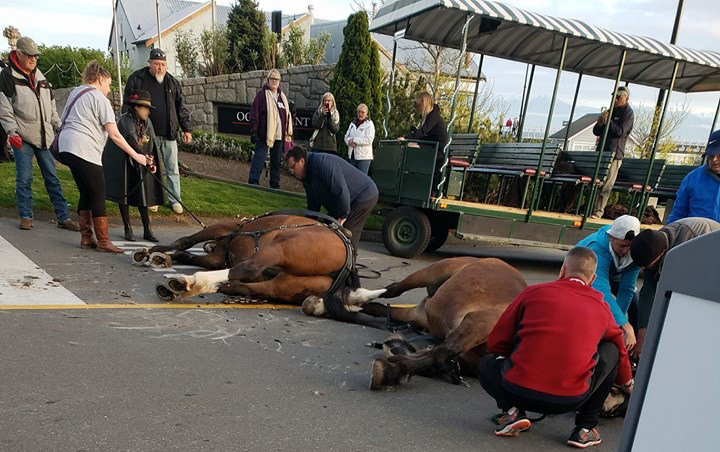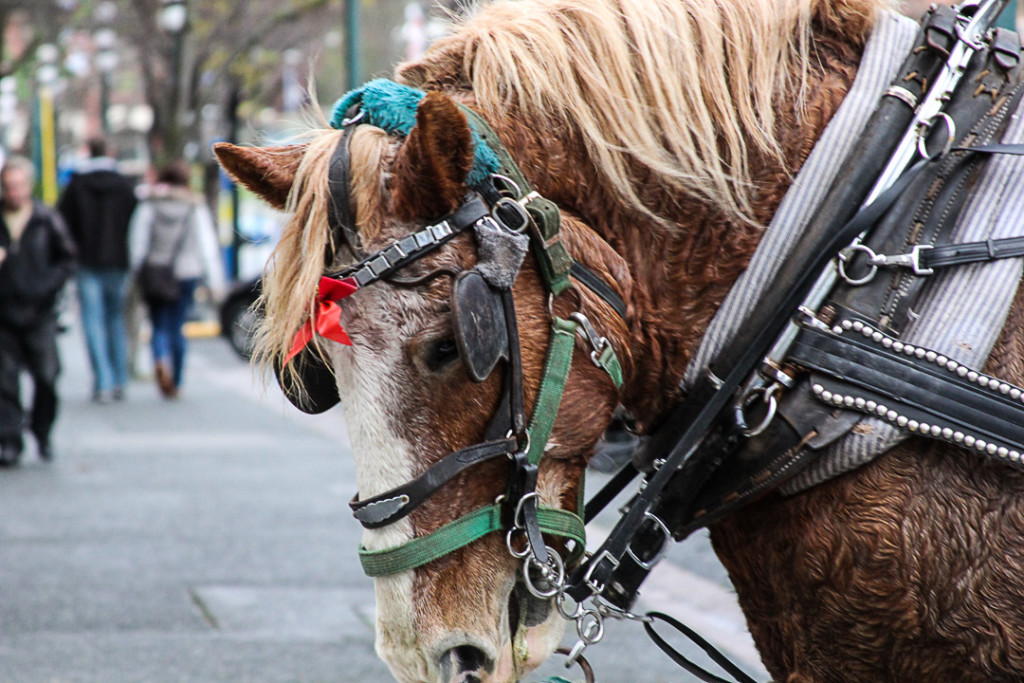Cruelty and More
Cruelty is often not blatant, it can be subtle and not easily recognizable by people who do not have an educated understanding of an animals physiology. That is why any claims we make regarding the care or operation of the horse carriages are supported by the experience of qualified third-party individuals.
Because of the documented abusive, aggressive, and overall disrespectful language of the people associated with and supporting the horse carriage industry. We are not posting publicly the names of any of the professionals we work with, so that they may not face further harassment from these people. We encourage a culture of safe and respectful discussion, and are extremely disappointed with the behaviour of the carriage industry supporters thus far.
Animal Performances
The City of Victoria passed a bylaw many years ago banning the use of animals for performances out of concerns for animal cruelty. However, horse carriages fell through the cracks of this bylaw and these animals have been forced to continue to perform in the city streets for tourists. This is exploitation and objectification of horses as a cultural symbol of a bygone era when animals were severely abused. It is time Victoria ended this contravention of its own bylaw and removed the horse carriages from our streets.
Here is the reading of the bylaw:
Animal performances:
16 (1) A person must not operate or carry on a public show, exhibition, carnival or performance in which animals are required to perform tricks, fight or otherwise participate for the amusement or entertainment of an audience.
(2) Despite subsection (1), a person may operate or carry on:
(a) an exhibition or performance involving horses or in which individuals ride horses or ponies;
(b) an exhibition involving dogs;
(c) a display or showing of animals in an agricultural fair or pet show; or
(d) an event that is conducted in accordance with a permit issued by the Director of Parks, Recreation and Culture;
if the person does not use or treat any animal in an inhumane manner for profit or advantage.
You can view the entire Animal Control bylaw here.
Inhumane Foot Care
These are just a few of the hundreds of images we have taken of horse carriage horses feet in Victoria. We have asked certified farriers and journeyman farriers for their opinion on the condition of the horses feet showing pictures like these and more. They were appalled and we were advised to bring this to the attention of the BCSPCA. We have filed two cruelty complaints with the BCSPCA thus far.
The response from the carriage industry has been that the horses passed their vet checks despite this evidence of poor care. Some issues about this:
- A vet is not a horse foot specialist, a farrier is. That is why we had qualified professional farriers assess this evidence. This is just like how you don’t go to your regular doctor to have your teeth looked at, you go to a dentist who is a teeth specialist.
- A vet health check is only an assessment of current health, it does not necessarily take into account the working pain, discomfort, or long term damage that could be caused by the current practice.
- A “certificate” of completing of an entry level course (possibly online based) and an “eight-week diploma” in horseshoeing are the qualifications provided by the carriage industry from their farrier. These should not be taken as proper “Certification” or as being competently qualified, as is evident from the work being done.
- However, there are no laws in Canada that say a horse requires Certified Journeyman foot care, even when they are working in city streets. This is because of the high cost of getting a qualified farrier to do this work, so many business pay far less for shoddy work that passes, but could cause long-term damage, pain, and discomfort.
The Effect of the Bit
The Bit, is a metal bar that sits in an inter-dental region of a horses mouth. It is used by the rider or driver to communicate with the horse by applying pressure to this sensitive area of the mouth, this in turn causes the horse to react out of fear of further pressure or pain. This is a common tool used throughout the equestrian industry and is widely defended as a standard industry practice.
There is evidence that the bit can cause significant health problems in horses, both physiological and psychological. A horse may find the bit uncomfortable and so to control them from trying to displace the bit, a nose band may be used to suppress any undesirable behaviour that comes from this discomfort.
Dr. Cook has written in the Journal of Equine Veterinary Science about the consequences of the bit. This is a peer reviewed journal. You can see the abstract here, but it does cost money to view the full report. Here you can find another report.
Carriage operators argue that the bit does not cause pain unless used incorrectly, they argue it is only meant to apply pressure to this sensitive area to communicate. However, the point of applying pressure is to demand obedience and the pressure works because the horse does not want more pressure applied leading to pain. There is no argument around the fact that bit is a tool of pain used to coerce a horse to do the riders bidding, it just happens to be that this is common practice, so few people challenge the status quo on this issue.
In The City
Hindrance to Traffic:
Another issue in regards to effects on traffic is the speed of the horse carriages. As is stated in the Travel Lane section for Street Occupancy Permits:
Impacts to travel lanes on arterial roads are not permitted based on time of day and direction. Inbound lanes from 6-9 a.m. and Outbound lanes from 3-6 p.m.
While the horse carriages do not operate prior to 9 a.m., they do operate during peak hours of traffic from 3-6 p.m. These parking stands do not necessarily inhibit the flow of traffic from James Bay through Menzies St. onto Belleville to a significant degree. However, the horse carriages do appear to slow the flow of traffic once they are in it.
Horse carriages are not well suited for operation in city traffic. They are slower than any other vehicle on the road and their design makes them unwieldy for maneuvering amongst fast moving and more agile vehicles.
As expected, the data showed a significant difference in the travelling speeds between horse carriages and motorized vehicles.
To provide evidence of this hindrance to traffic, we documented the speeds of vehicles along two common thoroughfares taken by the horse carriages. Speed observations were taken along both Belleville St. in front of the Legislature and Government St. in front of The Empress between the hours of 11am and 1pm, of both motor vehicles and horse carriages. Eight observations were made of each vehicle type in each location and the average speed, or mean, in km per hour is provided below.
| Horse Carriage | Motor Vehicle | Difference | |
| Belleville St. | 4.56 | 22.2 | 17.64 km/hr |
| Government St. | 5.37 | 39 | 33.63km/hr |
This data is important in an analysis of the operation of the horse carriages because vehicles that can barely maintain a quarter speed of the motor vehicles around them will undoubtedly cause frustration, as it hinders the movement of traffic to an unreasonable degree. This further endangers the safety of the horses, other drivers, cyclists, and pedestrians when it happens.
Costs to the City
Lost Parking Revenue:
It should be pointed out that no alternative business is necessary for the current space occupied by the horse carriages. Returning the space to parking stalls would add to Victoria’s limited supply of parking stalls in an area that is heavily used by tourists and locals alike. This would generate income for the city of approximately $49,000 a year based on six day a week use (free parking Sunday) and the standard $20/day/per stall ticketing of 4 stalls per side.
Potential Parking Revenue / Horse Stall Revenue
$80 per side/day = $160 $1170 per month x 2 = $2340
$160 x 312 = $49,920 $2340 per month x12 = $28,080
Currently, horse carriage stall rentals bring in $28,080 per year combined. Transitioning back to parking spaces would generate an extra $21, 840 in revenue for the city. It also provides a useful public service, instead of a private service that provides no apparent public value.
Sustainability
Many people are aware of the tremendous quantities of water, food, and resources involved in animal agriculture. Keeping a horse is no exception.
A horse resting in pasture consumes 30-40 litres of water per day; a working horse can consume up to 10 times that much. At the low end of 200 litres of water a day, a working horse would consume 73,000 litres of water in a year. Recently, the carriage industry announced they have over 5o horses in their care. At an average of two horses per side/per day, just the working horses consume on the low end 292,000 litres of water per year with those on the farm not being accounted for. If we figure the remaining horses in at 25 per company and an average of 40 litres of water a day, consumption would amount to another 730,000 litres of water per year. Combined, this amounts to 1,022,000 litres of water per year. These are very low estimates and do not take into account that many of the horses will consume more due to being worked, as well as the considerable amount of food, 15-20lbs of hay per day, cleaning, etc. required to maintain the horses weight and energy.
The horse carriages are an extremely energy intensive industry that requires tremendous inputs to sustain it. Also, these horses are driven in and out of the city on a daily basis adding fossil fuels to the mix. Water resources are a precious commodity and there is no reason for our community to be putting over a million litres of clean water into an unnecessary tourist industry that could easily be replaced by people powered tourism. Anytime that we take resources and put them into supporting another animal to do something we can do ourselves or without, we are wasting resources. Horse carriages are not environmentally sustainable, they are environmentally wasteful.

